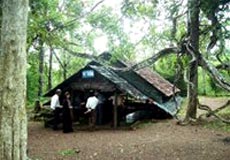Many changes have occurred in the large basaltic area of Bom Bo Village in the southern province of Binh Phuoc, which shelters the hamlets of the ethnic M’nong, S’tieng and Khmer peoples. This is a fascinating destination for learning about the culture and life of ethnic groups.
 Located 10 kilometers from Duc Phong Town, Bu Dang District, Bom Bo Village is considerably different from what it used to be. Local villagers have adapted to modern life and their culture, customs and trading activities now resemble those of other minority groups nationwide, said Do Manh Con, head of Bu Dang District’s Department of Culture and Information.
Located 10 kilometers from Duc Phong Town, Bu Dang District, Bom Bo Village is considerably different from what it used to be. Local villagers have adapted to modern life and their culture, customs and trading activities now resemble those of other minority groups nationwide, said Do Manh Con, head of Bu Dang District’s Department of Culture and Information.
Moreover, the village has built Bom Bo Village Cultural House to store and preserve artifacts of the culture and lifestyle of Stieng and M’nong peoples. Located on the peak of a large hill, the cultural house displays rice mortars, papooses, ancient jewelry, weaving looms, brocade, arcs, bow and cross-bows and water gourd. In the cultural house visitors will see stilt houses and in a corner of the showroom is a small status of a Stieng hero named Dieu Ong, who led the villagers on many victorious protests against French colonization.
About 15 kilometers from Bu Dang District, Binh Phuoc Province, on National Road No.14, is Bau Lach, home to tortoises, snakes, fish and birds. In the Stieng language Lach means grass while Bau means lake with water.
Nestled in primeval forests, Bau Lach is in a 500-hectare area of grassland that looks like an immense green carpet in the wild nature.
The unique aspect of this area is the proximity of the grass covered land to primeval forests; they lie adjacent but do not overlap even by one meter. They have clear borders. Old Stieng villagers explain that geology experts have concluded that this is due to special components, structures and chemical elements in the soil.
Leaving behind the impressive Bau Lach, next stop is Thac Mo Town in Phuoc Long District, home of 733-meter-high Ba Ra Mountain. From the mountain peak, one can see vast green land stretching to the horizon and preserved primeval forests with giant ancient trees of up to 100 meters height. The surrounding area is beautiful and romantic, with reeds and violet wild flowers. Long Thuy Lake at the foot of the mountain looks like a 12,000 hectare mirror reflecting a wonderful water color painting. Its capacity of 1.7 billion cubic meters is a source for the modern Thac Mo hydroelectric plant.
The tour continues to Loc Ninh Rubber Plantation, a well known historical site in the province. Loc Ninh was a familiar name in the war when thousands of people were transported by rail from Saigon to work in rubber plantations in Loc Ninh. In summer 1972 this was the first place in Southern Vietnam to be liberated when the South Vietnamese army was forced to leave.
The airport in Loc Linh Plantation is also a historical site; 43,000 prisoners of war were released here after the Paris Peace Accords of 1973.